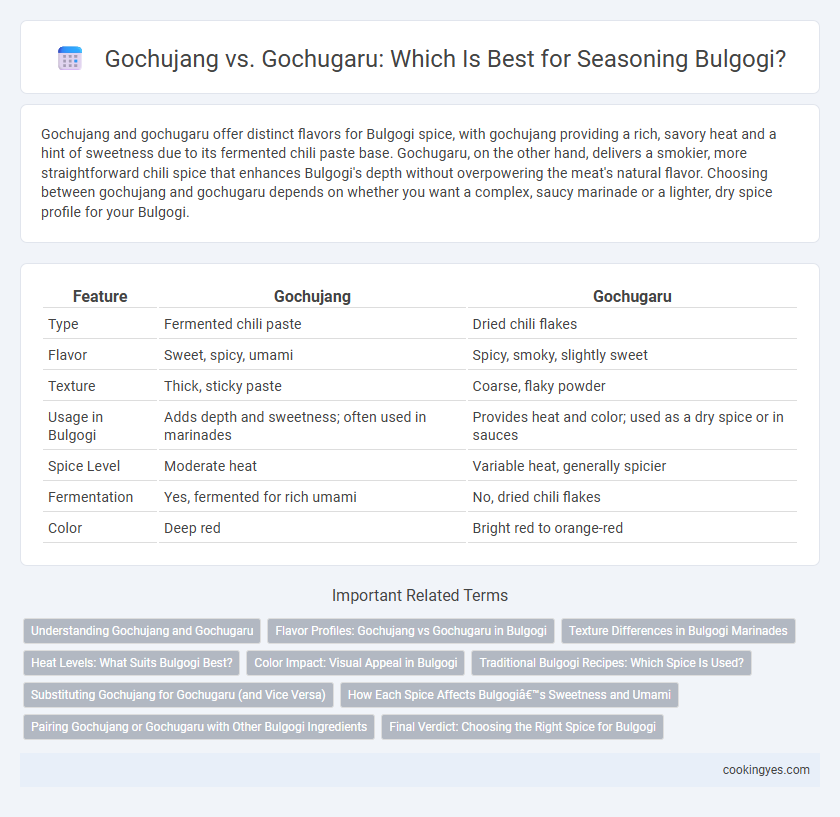Gochujang and gochugaru offer distinct flavors for Bulgogi spice, with gochujang providing a rich, savory heat and a hint of sweetness due to its fermented chili paste base. Gochugaru, on the other hand, delivers a smokier, more straightforward chili spice that enhances Bulgogi's depth without overpowering the meat's natural flavor. Choosing between gochujang and gochugaru depends on whether you want a complex, saucy marinade or a lighter, dry spice profile for your Bulgogi.
Table of Comparison
| Feature | Gochujang | Gochugaru |
|---|---|---|
| Type | Fermented chili paste | Dried chili flakes |
| Flavor | Sweet, spicy, umami | Spicy, smoky, slightly sweet |
| Texture | Thick, sticky paste | Coarse, flaky powder |
| Usage in Bulgogi | Adds depth and sweetness; often used in marinades | Provides heat and color; used as a dry spice or in sauces |
| Spice Level | Moderate heat | Variable heat, generally spicier |
| Fermentation | Yes, fermented for rich umami | No, dried chili flakes |
| Color | Deep red | Bright red to orange-red |
Understanding Gochujang and Gochugaru
Gochujang, a fermented red chili paste, offers Bulgogi a rich, sweet, and spicy flavor with a thick, smooth texture that enhances marinade depth. Gochugaru, consisting of dried red chili flakes, provides a more smoky, mildly spicy heat and a granular texture ideal for controlling spiciness and adding complexity. Understanding the differences between gochujang and gochugaru helps tailor Bulgogi seasoning, balancing sweetness, heat, and texture for authentic Korean barbecue taste.
Flavor Profiles: Gochujang vs Gochugaru in Bulgogi
Gochujang offers a rich, savory, and slightly sweet flavor with a deep umami essence that enhances Bulgogi with a bold, fermented taste. Gochugaru provides a more straightforward heat, adding a smoky, mildly spicy kick without the sweetness, allowing the natural beef flavors to shine. Choosing between gochujang and gochugaru depends on whether a sweeter, more complex spice or a clean, vibrant heat is desired in the Bulgogi marinade.
Texture Differences in Bulgogi Marinades
Gochujang creates a thick, sticky texture in Bulgogi marinades, providing a rich and slightly chewy coating that enhances caramelization during cooking. In contrast, gochugaru produces a lighter, grainier texture that allows the marinade to penetrate the meat more deeply without adding viscosity. Choosing between gochujang and gochugaru significantly affects the mouthfeel and consistency of the final Bulgogi dish, balancing sweetness, heat, and texture.
Heat Levels: What Suits Bulgogi Best?
Gochugaru offers a moderate heat level with smoky, slightly sweet undertones ideal for enhancing Bulgogi without overpowering its tender, marinated beef flavors. Gochujang provides a thicker texture and a more intense, spicy-sweet profile that can dominate the delicate balance of Bulgogi's savory marinade. For optimal heat and flavor harmony, many chefs prefer the controlled spice of gochugaru to complement Bulgogi's subtle sweetness and umami.
Color Impact: Visual Appeal in Bulgogi
Gochujang adds a deep red, glossy finish to Bulgogi, enhancing its visual appeal with a rich, vibrant hue that signals bold flavor. Gochugaru provides a brighter, more textured appearance due to its crushed chili flakes, creating a speckled red color that emphasizes a rustic, spicy look. Choosing between gochujang and gochugaru significantly affects the color impact, influencing not only the dish's aesthetic but also the perceived flavor intensity.
Traditional Bulgogi Recipes: Which Spice Is Used?
Traditional bulgogi recipes primarily use gochugaru, Korean red chili pepper flakes, to add a subtle heat and vibrant color without overpowering the dish's savory-sweet marinade. Gochujang, a fermented chili paste, is less common in authentic bulgogi, as its intense flavor and sweetness can mask the delicate balance of soy sauce, garlic, and sesame oil essential to traditional preparations. Authentic cooks often prefer gochugaru to maintain the classic, mild spiciness that complements the tender marinated beef perfectly.
Substituting Gochujang for Gochugaru (and Vice Versa)
Gochujang, a fermented chili paste with a sweet and savory depth, adds a rich, sticky texture to Bulgogi, while gochugaru, Korean chili flakes, provide a lighter, smoky heat and more control over spice intensity. Substituting gochugaru for gochujang requires adding a sweetener like honey or sugar and a savory element such as soy sauce or miso to mimic gochujang's umami complexity. Using gochujang in place of gochugaru may overpower the dish's subtle flavors and alter cooking consistency due to its thicker, paste-like form.
How Each Spice Affects Bulgogi’s Sweetness and Umami
Gochujang lends Bulgogi a deep, complex sweetness and rich umami through its fermented soybean base and chili paste blend, intensifying the dish's savory profile. Gochugaru, with its pure chili flakes, provides a sharper, smokier heat that accentuates the meat's natural sweetness while maintaining a lighter umami presence. The choice between gochujang and gochugaru significantly shapes Bulgogi's flavor balance, emphasizing either sweeter, bolder umami or a cleaner, spicier heat.
Pairing Gochujang or Gochugaru with Other Bulgogi Ingredients
Gochujang's rich, fermented sweetness enhances bulgogi by blending seamlessly with soy sauce and garlic, creating a balanced umami depth ideal for marinating beef. Gochugaru delivers a vibrant, smoky heat that complements sesame oil and ginger, adding a spicy kick without overpowering the tender, savory flavors. Pairing gochujang with sugar and scallions intensifies the sauce's complexity, while gochugaru works well alongside onions and black pepper to elevate bulgogi's overall aroma and texture.
Final Verdict: Choosing the Right Spice for Bulgogi
Gochujang and gochugaru each bring distinct flavors to Bulgogi, with gochujang providing a rich, fermented sweetness and gochugaru contributing a clean, smoky heat. For a traditional Bulgogi marinade emphasizing depth and umami, gochujang is the preferred choice, enhancing the meat's caramelization during grilling. Gochugaru suits those seeking a lighter, spicier kick, making it ideal for a less sweet, more vibrant seasoning profile.
Gochujang vs gochugaru for Bulgogi spice Infographic

 cookingyes.com
cookingyes.com